|
|
Post by stardiamond on Jun 4, 2019 14:34:09 GMT -5
I needed to fix a sold cab that had a fracture. I marked the center line and ground off the fracture. I handed it to my wife and she put a few pencil marks on the back edges, just to indicate the general area. I took a few swipes on the 220 and showed it to her; nailed it. That went a lot easier than expected. Cleaned up the girdle, sanded and polished. It even fell off the dop stick in the freezer and left no glue behind. I cut a 1/2 inch of Deschutes wit a fracture and made a new bottom and that went well. I went back to 325 on a Morgan Hill that had been tieing up a dop stick for some time. The fun part was the Blue Mountain with druse and a rhodochrosite scrap. Both were flat tops. The rhodochrosite was uneven and I ground the edges even, flattened the top and gave it a shape. Years ago the pattern on it was a big deal. I just wanted to see how it polished and spent less than a 1/2 hour on it. Best of all my thumb is doing ok. 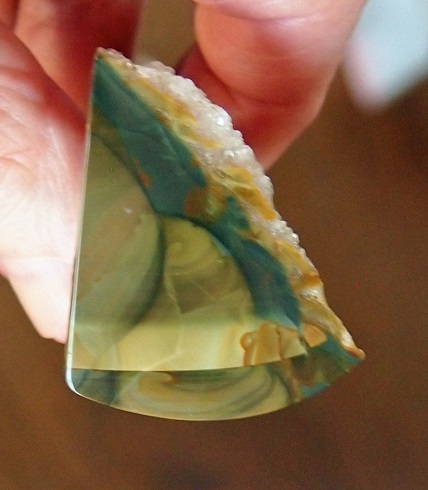 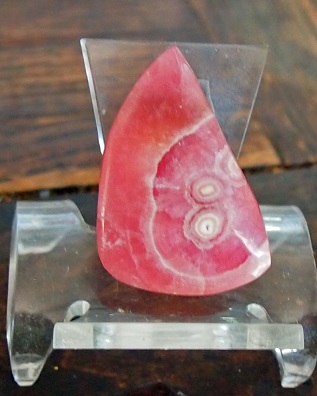 |
|
|
|
Post by stardiamond on Jun 4, 2019 16:04:46 GMT -5
I can't get the mirror polish to show. Better brightness. 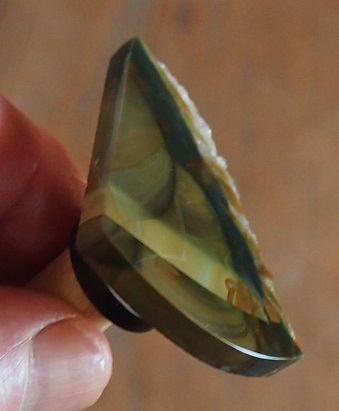 |
|
|
|
Post by rockjunquie on Jun 4, 2019 16:28:38 GMT -5
I needed to fix a sold cab that had a fracture. I marked the center line and ground off the fracture. I handed it to my wife and she put a few pencil marks on the back edges, just to indicate the general area. I took a few swipes on the 220 and showed it to her; nailed it. That went a lot easier than expected. Cleaned up the girdle, sanded and polished. It even fell off the dop stick in the freezer and left no glue behind. I cut a 1/2 inch of Deschutes wit a fracture and made a new bottom and that went well. I went back to 325 on a Morgan Hill that had been tieing up a dop stick for some time. The fun part was the Blue Mountain with druse and a rhodochrosite scrap. Both were flat tops. The rhodochrosite was uneven and I ground the edges even, flattened the top and gave it a shape. Years ago the pattern on it was a big deal. I just wanted to see how it polished and spent less than a 1/2 hour on it. Best of all my thumb is doing ok.  
Sounds like you had a GREAT cabbing day! Can't say the same for myself. 
That rhodo is JUICY! Now that you have saved the druzy, I can see why you went with your instinct. Looks good.  |
|
|
|
Post by stardiamond on Jun 4, 2019 17:43:12 GMT -5
Excellent cabbing day. Not a good day for pictures. I took a lot and didn't like them. I did get a an ok picture of the MH to send to the buyer and she was pleased with the result. 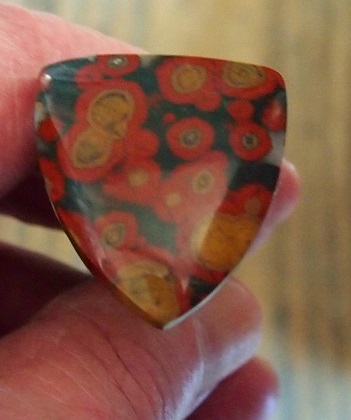 |
|
Deleted
Deleted Member
Member since January 1970
Posts: 0
|
Post by Deleted on Jun 7, 2019 6:00:25 GMT -5
I like them all,
The poppy is Screamin’!!
|
|
|
|
Post by stardiamond on Jun 7, 2019 13:04:51 GMT -5
|
|
|
|
Post by rockjunquie on Jun 7, 2019 13:24:55 GMT -5
That's a really nice Deschutes!
|
|
NevadaBill
fully equipped rock polisher
  
Member since January 2019
Posts: 1,332
|
Post by NevadaBill on Jun 7, 2019 13:36:57 GMT -5
Those are all beautiful. I like the freeforms technique used on a lot of them.
I am brand new to this cabbing stuff, but I think that if I have a creative imagination (and great rough like yours), and patience that I could probably come up with neat designs like yours.
Thank you for sharing!
|
|
|
|
Post by stardiamond on Jun 7, 2019 14:57:56 GMT -5
Those are all beautiful. I like the freeforms technique used on a lot of them. I am brand new to this cabbing stuff, but I think that if I have a creative imagination (and great rough like yours), and patience that I could probably come up with neat designs like yours. Thank you for sharing! Thank you for your kind words. Plan a is a symmetrical shape. When a shape doesn't fit a scene, I will block out some lines and then put some curves in in a way I like. Looking at the round bottom on the Tahoma, I'm guessing the cab broke and it was a rescue effort. The BM was a 40x30 pear that had pits on the right side, so I cut it away and rounded out what was left. When I first started doing free forms, I would use another freeform as a template; choosing one that best fit the scene. Now I wing it. I took off a few years from cabbing and wasn't happy with my technique. I was too dependent on girdle lines and now I am getting better at following the light on girdles and domes. Having great material is the first step to making a good cab. I've been buying material for a long time and most of it 10+ years ago. Finding reasonably priced material is harder now. Until recently, I cut cabs to please me, not for sale and I can use material that I like even if it isn't popular. I spend a lot of time looking at a pile of slabs looking for scenes. I move a 30x24 or 30x40 template around the slab to find scenes not necessarily to cut those shapes. It's a great hobby. |
|
NevadaBill
fully equipped rock polisher
  
Member since January 2019
Posts: 1,332
|
Post by NevadaBill on Jun 8, 2019 18:56:24 GMT -5
Thank you for taking the time to describe some of your techniques. I am going to copy this in to my notes that I am building for a reference on cabbing.
I would prefer not to deviate this thread, but my observations on Freeforms so far, it appears that many people start with a shape which can be found on a template, and stick to that template form for part of; or most of, the circumference. Then deviate from the template to either work around a flawed chunk of material in the rock, or do the opposite (incorporate a unique or striking feature of the material, in to their basic template design by Freeform'ing the remainder. I don't think I was able to put that in words very good.
I've bookmarked your stardiamonddesigns ETSY shop. I think you have a good eye and imagination for getting the best out of the material you work with.
|
|
|
|
Post by rockjunquie on Jun 10, 2019 7:48:05 GMT -5
Thank you for taking the time to describe some of your techniques. I am going to copy this in to my notes that I am building for a reference on cabbing. I would prefer not to deviate this thread, but my observations on Freeforms so far, it appears that many people start with a shape which can be found on a template, and stick to that template form for part of; or most of, the circumference. Then deviate from the template to either work around a flawed chunk of material in the rock, or do the opposite (incorporate a unique or striking feature of the material, in to their basic template design by Freeform'ing the remainder. I don't think I was able to put that in words very good. I've bookmarked your stardiamonddesigns ETSY shop. I think you have a good eye and imagination for getting the best out of the material you work with. Sometimes, a preform will break when cutting it. That leads to freeforms, too. |
|
|
|
Post by stardiamond on Jun 13, 2019 11:39:50 GMT -5
I finished the Morrisonite recut. Except for being thin, it came out nice. 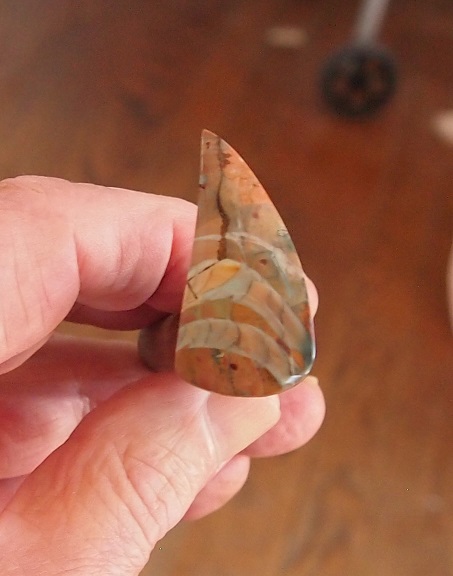 |
|
|
|
Post by miket on Jun 13, 2019 12:34:21 GMT -5
As always, beautiful and inspiring work.
|
|